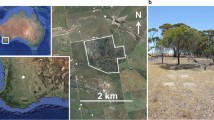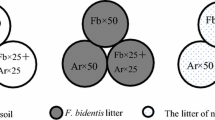Abstract
High litter mass is hypothesized to produce an invader-directed invasion by changing ecosystem properties such as nutrient cycling rates and light availability. An invasive plant species that stimulates litter accumulation may induce a positive feedback when it benefits from high litter conditions. Phalaris arundinacea is an invasive wetland grass that may induce positive litter feedback, as it produces abundant litter that varies in quality due to a wide range of foliar C:N content. In this study we investigated the range of growth responses within native and invasive genotypes of Phalaris that varied in initial foliar C:N levels (high C:N content was present in the invasive genotypes) when grown under varying litter mass. Overwintering with high litter reduced establishing tiller survivorship and the presence of litter delayed tiller emergence by 2 weeks. Overall, genotypes exhibited high trait plasticity in response to litter. Our results indicate that high litter mass can stimulate Phalaris growth, specifically for the genotypes with high initial C:N foliar tissue. Additionally, genotypes with initially high C:N ratios exhibited plastic responses consistent with a Master-of-some strategy indicating that their performance under high litter may depend upon the nutrient conditions under which they are grown. This study provides evidence for conditions that may lead to a positive feedback in Phalaris’ introduced range. Future studies should investigate how changing litter quantity alters nutrient cycling and competitor growth.




Similar content being viewed by others
References
Adams CR, Galatowitsch SM (2006) Increasing the effectiveness of Reed canary grass (Phalaris arundinacea L.) control in wet meadow restorations. Restor Ecol 14(3):441–451. doi:10.1111/j.1526-100X.2006.00152.x
Allison SD, Vitousek PM (2004) Rapid nutrient cycling in leaf litter from invasive plants in Hawai’i. Oecologia 141(4):612–619. doi:10.1007/s00442-004-1679-z
Apfelbaum SI, Sams CE (1987) Ecology and control of reed canary grass. Nat Areas J 7:69–74
Armas C, Ordiales R, Pugnaire FI (2004) Measuring plant interactions: a new comparative index. Ecology 85(10):2682–2686
Armbrecht I, Perfecto I, Vandermeer J (2004) Enigmatic biodiversity correlations: ant diversity responds to diverse resources. Science 304(5668):284–286. doi:10.1126/science.1094981
Barnes WJ (1999) The rapid growth of a population of reed canarygrass (Phalaris arundinacea L.) and its impact on some riverbottom herbs. J Torrey Bot Soc 126(2):133–138
Brooks ML, D’Antonio CM, Richardson DM, Grace JB, Keeley JE, DiTomaso JM, Hobbs RJ, Pellant M, Pyke D (2004) Effects of invasive alien plants on fire regimes. Bioscience 54(7):677–688. doi:10.1641/0006-3568(2004)054[0677:eoiapo]2.0.co;2
Cameron GN, Spencer SR (1989) Rapid leaf decay and nutrient release in a Chinese tallow forest. Oecologia 80(2):222–228
Carvalho LM, Antunes PM, Martins-Loução MA, Klironomos JN (2010) Disturbance influences the outcome of plant–soil biota interactions in the invasive Acacia longifolia and in native species. Oikos 119(7):1172–1180. doi:10.1111/j.1600-0706.2009.18148.x
Cohen JS, Maerz JC, Blossey B (2011) Traits, not origin, explain impacts of plants on larval amphibians. Ecol Appl 22(1):218–228. doi:10.1890/11-0078.1
Collins A, Hart E, Molofsky J (2010) Differential response to frequency-dependent interactions: an experimental test using genotypes of an invasive grass. Oecologia 164(4):959–969. doi:10.1007/s00442-010-1719-9
Crooks J, Soule ME (1999) Lag times in population explosions of invasive species: causes and implications. In: Sandlund OT, Schei PJ, Viken Å (eds) Invasive species and biodiversity management. Kluwer Academic Publishers, Dordrecht, pp 103–125
Crooks JA (2002) Characterizing ecosystem-level consequences of biological invasions: the role of ecosystem engineers. Oikos 97(2):153–166
Cuddington K, Hastings A (2004) Invasive engineers. Ecol Model 178(3–4):335–347
Dohleman FG, Heaton EA, Arundale RA, Long SP (2012) Seasonal dynamics of above- and below-ground biomass and nitrogen partitioning in Miscanthus × giganteus and Panicum virgatum across three growing seasons. GCB Bioenergy:n/a-n/a. doi:10.1111/j.1757-1707.2011.01153.x
Efron B, Tibshirani RJ (1993) An introduction to the bootstrap. Chapman and Hall, New York
Ehrenfeld JG (2003) Effects of exotic plant invasions on soil nutrient cycling processes. Ecosystems 6(6):503–523. doi:10.1007/s10021-002-0151-3
Ehrenfeld JG (2010) Ecosystem consequences of biological invasions. Annu Rev Ecol Evol Syst 41(1):59–80. doi:10.1146/annurev-ecolsys-102209-144650
Ehrenfeld JG, Kourtev P, Huang W (2001) Changes in soil functions following invasions of exotic understory plants in deciduous forests. Ecol Appl 11(5):1287–1300
Ehrenfeld JG, Ravit B, Elgersma K (2005) Feedback in the plant-soil system. Ann Rev Environ Resour 30(1):75–115. doi:10.1146/annurev.energy.30.050504.144212
Eppinga MB, Kaproth MA, Collins AR, Molofsky J (2011) Litter feedbacks, evolutionary change and exotic plant invasion. J Ecol 99(2):503–514. doi:10.1111/j.1365-2745.2010.01781.x
Eppinga MB, Molofsky J (2012) Eco-evolutionary litter feedback as a driver of exotic plant invasion. Perspect Plant Ecol Evol Syst. doi:10.1016/j.ppees.2012.10.006
Eppinga MB, Rietkerk M, Belyea LR, Nilsson MB, Ruiter PCD, Wassen MJ (2010) Resource contrast in patterned peatlands increases along a climatic gradient. Ecology 91(8):2344–2355. doi:10.1890/09-1313.1
Facelli J, Pickett S (1991) Plant litter: its dynamics and effects on plant community structure. Bot Rev 57(1):1–32. doi:10.1007/bf02858763
Farrer EC, Goldberg DE (2009) Litter drives ecosystem and plant community changes in cattail invasion. Ecol Appl 19(2):398–412. doi:10.1890/08-0485.1
Hartnett DC, Bazzaz FA (1983) Physiological integration among intraclonal ramets in Solidago canadensis. Ecology 64(4):779–788
Hefting MM, Clement J-C, Bienkowski P, Dowrick D, Guenat C, Butturini A, Topa S, Pinay G, Verhoeven JTA (2005) The role of vegetation and litter in the nitrogen dynamics of riparian buffer zones in Europe. Ecol Eng 24(5):465–482
Hobbie SE (1992) Effects of plant species on nutrient cycling. Trends Ecol Evol 7(10):336–339
Holdredge C, Bertness M (2011) Litter legacy increases the competitive advantage of invasive Phragmites australis in New England wetlands. Biol Invasions 13(2):423–433. doi:10.1007/s10530-010-9836-2
Hovstad K, Ohlson M (2008) Physical and chemical effects of litter on plant establishment in semi-natural grasslands. Plant Ecol 196(2):251–260. doi:10.1007/s11258-007-9349-y
Hulme PE, Pyšek P, Duncan RP (2011) Don’t be fooled by a name: a reply to Thompson and Davis. Trends Ecol Evolut 26:318. doi:10.1016/j.tree.2011.03.018
Jordan N, Larson D, Huerd S (2008) Soil modification by invasive plants: effects on native and invasive species of mixed-grass prairies. Biol Invasions 10(2):177–190. doi:10.1007/s10530-007-9121-1
Killham K, Wainwright M (1981) Deciduous leaf litter and cellulose decomposition in soil exposed to heavy atmospheric pollution. Environ Pollut Ser A Ecol Biol 26(1):79–85. doi:10.1016/0143-1471(81)90100-8
Lavergne S, Molofsky J (2004) Reed canary grass (Phalaris arundinacea) as a biological model in the study of plant invasions. Crit Rev Plant Sci 23(5):415–429
Lavergne S, Molofsky J (2006) Control strategies for the invasive reed canarygrass (Phalaris arundinacea L.) in North American wetlands: the need for an integrated management plan. Nat Areas J 26(2):208–214. doi:10.3375/0885-8608(2006)26[208:csftir]2.0.co;2
Lavergne S, Molofsky J (2007) Increased genetic variation and evolutionary potential drive the success of an invasive grass. Proc Natl Acad Sci 104(10):3883–3888. doi:10.1073/pnas.0607324104
Lenssen JPM, Menting FBJ, Van der Putten WH, Blom CWPM (2000) Variation in species composition and species richness within Phragmites australis dominated riparian zones. Plant Ecol 147(1):137–146. doi:10.1023/a:1009869109179
Lesica P (1997) Spread of Phalaris arundinacea adversely impacts the endangered plant Howellia aquatilis. Great Basin Nat 57(4):366–368
Levine JM, Vilà M, Antonio CMD, Dukes JS, Grigulis K, Lavorel S (2003) Mechanisms underlying the impacts of exotic plant invasions. Proc R Soc Lond B Biol Sci 270(1517):775–781. doi:10.1098/rspb.2003.2327
Liao C, Peng R, Luo Y, Zhou X, Wu X, Fang C, Chen J, Li B (2008) Altered ecosystem carbon and nitrogen cycles by plant invasion: a meta-analysis. New Phytol 177(3):706–714
Mack MC, D’Antonio CM (1998) Impacts of biological invasions on disturbance regimes. Trends Ecol Evol 13(5):195–198
Minchinton TE, Simpson JC, Bertness MD (2006) Mechanisms of exclusion of native coastal marsh plants by an invasive grass. J Ecol 94(2):342–354. doi:10.1111/j.1365-2745.2006.01099.x
Morrison J (2002) Wetland vegetation before and after experimental purple loosestrife removal. Wetlands 22(1):159–169. doi:10.1672/0277-5212(2002)022[0159:WVBAAE]2.0.CO;2
Morrison SL, Molofsky J (1998) Effects of genotypes, soil moisture, and competition on the growth of an invasive grass, Phalaris arundinacea (reed canary grass). Can J Bot 76(11):1939–1946. doi:10.1139/b98-157
Niklasch H, Joergensen RG (2001) Decomposition of peat, biogenic municipal waste compost, and shrub/grass compost added in different rates to a silt loam. J Plant Nutr Soil Sci 164(4):365–369. doi:10.1002/1522-2624(200108)164:4<365:aid-jpln365>3.0.co;2-y
Perry LG, Galatowitsch SM, Rosen CJ (2004) Competitive control of invasive vegetation: a native wetland sedge suppresses Phalaris arundinacea in carbon-enriched soil. J Appl Ecol 41(1):151–162. doi:10.1111/j.1365-2664.2004.00871.x
Richards CL, Bossdorf O, Muth NZ, Gurevitch J, Pigliucci M (2006) Jack of all trades, master of some? On the role of phenotypic plasticity in plant invasions. Ecol Lett 9(8):981–993. doi:10.1111/j.1461-0248.2006.00950.x
Sakai AK, Allendorf FW, Holt JS, Lodge DM, Molofsky J, With KA, Baughman S, Cabin RJ, Cohen JE, Ellstrand NC, McCauley DE, O’Neil P, Parker IM, Thompson JN, Weller SG (2001) The population biology of invasive species. Annu Rev Ecol Syst 32:305–332
Sharrow SH, Wright HA (1977) Effects of fire, ash, and litter on soil nitrate, temperature, moisture and tobosagrass production in the rolling plains. J Range Manag 30(4):266–270
Simberloff D (2011) Non-natives: 141 scientists object. Nature 475(7354):36
Simberloff D, Genovesi P, Pyšek P, Campbell K (2011) Recognizing conservation success. Science 332(6028):419. doi:10.1126/science.332.6028.419-a
Sokal RR, Rohlf FJ (1995) Biometry: the principles and practice of statistics in biological research, 3rd edn. W. H. Freeman and Co., New York
Suding KN, Gross KL, Houseman GR (2004) Alternative states and positive feedbacks in restoration ecology. Trends Ecol Evol 19(1):46–53
Thompson K, Davis MA (2011) Why research on traits of invasive plants tells us very little. Trends Ecol Evol 26(4):155–156
Treseder KK, Vitousek PM (2001) Potential ecosystem-level effects of genetic variation among populations of Metrosideros polymorpha from a soil fertility gradient in Hawaii. Oecologia 126(2):266–275
van Kleunen M, Dawson W, Dostal P (2011) Research on invasive-plant traits tells us a lot. Trends Ecol Evol 26(7):317. doi:10.1016/j.tree.2011.03.019
Van Vuuren MM, Aerts E, Berendse F, Visser W (1992) Nitrogen mineralization in heathland ecosystems dominated by different plant species. Biogeochemistry 16(3):151–166. doi:10.1007/bf00002816
Wedin DA, Tilman D (1990) Species effects on nitrogen cycling: a test with perennial grasses. Oecologia 84(4):433–441. doi:10.1007/bf00328157
Wetzel PR, Valk AG (1998) Effects of nutrient and soil moisture on competition between Carex stricta, Phalaris arundinacea, and Typha latifolia. Plant Ecol 138(2):179–190
Yelenik SG, Levine JM (2010) Native shrub reestablishment in exotic annual grasslands: do ecosystem processes recover? Ecol Appl 20(3):716–727. doi:10.1890/08-2365.1
Zedler JB (2009) Feedbacks that might sustain natural, invaded and restored states in herbaceous wetlands. In: Hobbs R, Suding KN (eds) New models for ecosystem dynamics and restoration. Island Press, Washington, pp 236–258
Zedler JB, Kercher S (2004) Causes and consequences of invasive plants in wetlands: opportunities, opportunists, and outcomes. Crit Rev Plant Sci 23(5):431–452
Acknowledgments
Sincerest thanks to our colleagues at the Odum Conference 2009, Rensselaerville, NY, our reviewers, as well as K. Alley, D. Barrington, R. Collins, A. DeSenna, M. Harlacher, D. Ross, L. Schmitt, E. Sorel, S. Strella and H. Tobi, for their contributions throughout the project. This research was supported by a USDA Hatch and USDA-NRI 2006-03645 Grant awarded to J. Molofsky.
Author information
Authors and Affiliations
Corresponding author
Appendix
Appendix
See Fig. 5.
Genotype mean differences (LRC; Eq. 1) between low litter-no litter treatments (top figure) or high litter-no litter treatments (bottom figure) for final measured traits: A tiller count, B leaf count, C maximum stem height, D root biomass, E shoot biomass, F root:shoot ratio, G total biomass, and H mass per tiller (±1 S.E). Genotypes are ranked uniformly (by the Figure A low litter-no litter tiller count LRC values). Native genotypes are on the left side (hollow bars numbered L1-4 for low C:N) while invasive genotypes are in solid bars numbered L5-8 (for low C:N) and H1-8 (for high C:N). Asterisks indicate litter effects that are significantly different from controls (*p < 0.1; **p < 0.05). Note Figure E has a larger y-axis range than the other figures. Due to low numbers of surviving replicates, two genotypes (#L5 and L8) were omitted in high litter figures
Rights and permissions
About this article
Cite this article
Kaproth, M.A., Eppinga, M.B. & Molofsky, J. Leaf litter variation influences invasion dynamics in the invasive wetland grass Phalaris arundinacea . Biol Invasions 15, 1819–1832 (2013). https://doi.org/10.1007/s10530-013-0411-5
Received:
Accepted:
Published:
Issue Date:
DOI: https://doi.org/10.1007/s10530-013-0411-5






